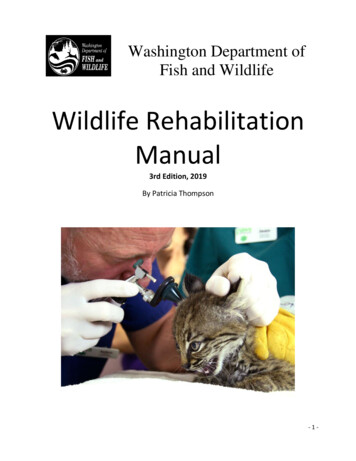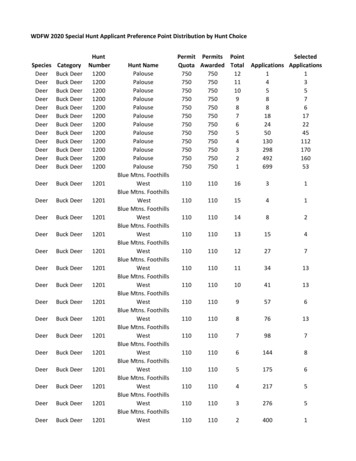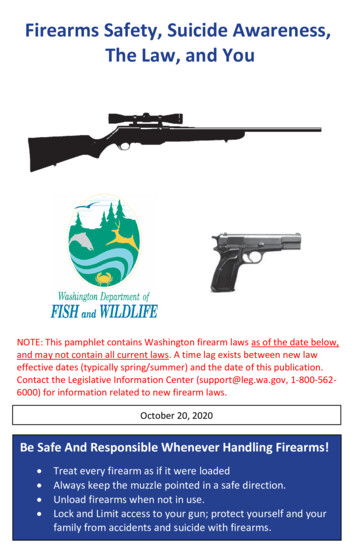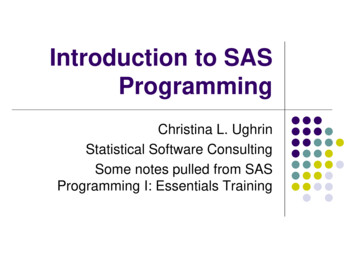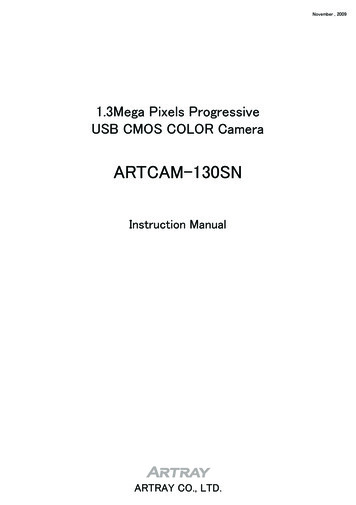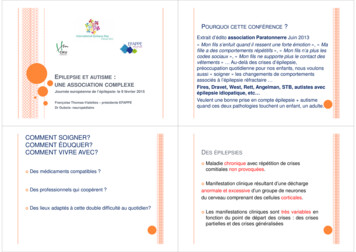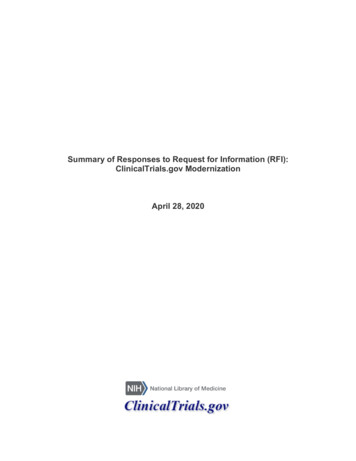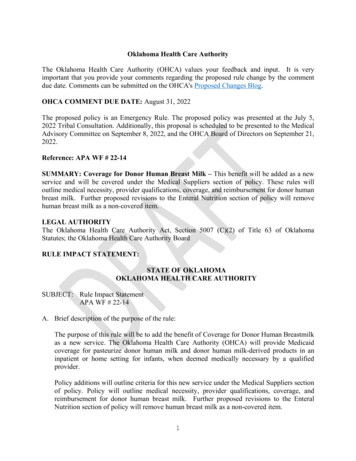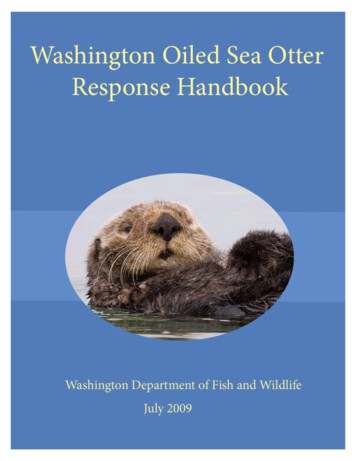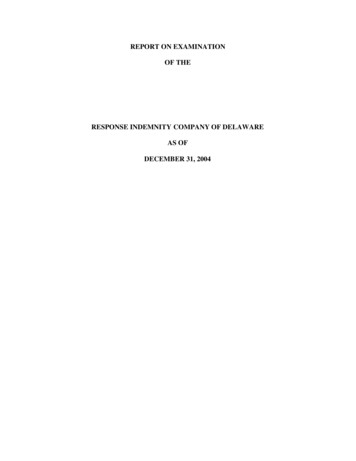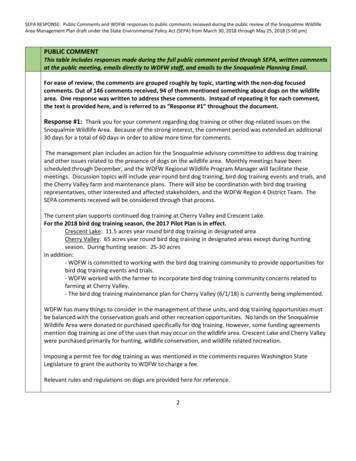
Transcription
SEPA RESPONSE: Public Comments and WDFW responses to public comments received during the public review of the Snoqualmie WildlifeArea Management Plan draft under the State Environmental Policy Act (SEPA) from March 30, 2018 through May 25, 2018 (5:00 pm)PUBLIC COMMENTThis table includes responses made during the full public comment period through SEPA, written commentsat the public meeting, emails directly to WDFW staff, and emails to the Snoqualmie Planning Email.For ease of review, the comments are grouped roughly by topic, starting with the non‐dog focusedcomments. Out of 146 comments received, 94 of them mentioned something about dogs on the wildlifearea. One response was written to address these comments. Instead of repeating it for each comment,the text is provided here, and is referred to as “Response #1” throughout the document.Response #1: Thank you for your comment regarding dog training or other dog‐related issues on theSnoqualmie Wildlife Area. Because of the strong interest, the comment period was extended an additional30 days for a total of 60 days in order to allow more time for comments.The management plan includes an action for the Snoqualmie advisory committee to address dog trainingand other issues related to the presence of dogs on the wildlife area. Monthly meetings have beenscheduled through December, and the WDFW Regional Wildlife Program Manager will facilitate thesemeetings. Discussion topics will include year‐round bird dog training, bird dog training events and trials, andthe Cherry Valley farm and maintenance plans. There will also be coordination with bird dog trainingrepresentatives, other interested and affected stakeholders, and the WDFW Region 4 District Team. TheSEPA comments received will be considered through that process.The current plan supports continued dog training at Cherry Valley and Crescent Lake.For the 2018 bird dog training season, the 2017 Pilot Plan is in effect.Crescent Lake: 11.5 acres year round bird dog training in designated areaCherry Valley: 65 acres year round bird dog training in designated areas except during huntingseason. During hunting season: 25‐30 acresIn addition:‐ WDFW is committed to working with the bird dog training community to provide opportunities forbird dog training events and trials.‐ WDFW worked with the farmer to incorporate bird dog training community concerns related tofarming at Cherry Valley.‐ The bird dog training maintenance plan for Cherry Valley (6/1/18) is currently being implemented.WDFW has many things to consider in the management of these units, and dog training opportunities mustbe balanced with the conservation goals and other recreation opportunities. No lands on the SnoqualmieWildlife Area were donated or purchased specifically for dog training. However, some funding agreementsmention dog training as one of the uses that may occur on the wildlife area. Crescent Lake and Cherry Valleywere purchased primarily for hunting, wildlife conservation, and wildlife related recreation.Imposing a permit fee for dog training as was mentioned in the comments requires Washington StateLegislature to grant the authority to WDFW to charge a fee.Relevant rules and regulations on dogs are provided here for reference.2
SEPA RESPONSE: Public Comments and WDFW responses to public comments received during the public review of the Snoqualmie WildlifeArea Management Plan draft under the State Environmental Policy Act (SEPA) from March 30, 2018 through May 25, 2018 (5:00 pm)The hunting regulations in the Washington State Migratory Waterfowl & Upland Game Bird Season, p.17,describe the bird dog training season as August 1 – March 31. It also states that “Dog training may beconducted year‐round on designated portions . [of the Snoqualmie Wildlife Area]. The Crescent Lake andCherry Valley units have designated areas for year‐round bird dog training opportunities.WAC 232‐12‐041 describes the permit required for holding field trials. “ (1) Except as authorized by permitissued by the director it is unlawful to hold field trials for hunting dogs during the months of April, May, June,and July. Field trials on department lands or those involving use of live wildlife may not be held without apermit.(2) Applications for a field trial permit must be filed with the department at least thirty days before theproposed date for holding such trials. The application shall state the time and place the field trials will beheld, the names of sponsors and persons who will conduct the trials, and such other information as thedirector may require.”WAC 232‐13‐180 describes the regulation of pets on the wildlife areas. “(1) The department may prohibit orregulate pets, except for bona fide service animals for persons with disabilities, on department lands. (2) It isunlawful for any person to allow pets to roam unattended on department lands. (3)(a) It is unlawful to causeor allow a pet to roam unleashed on department‐owned lands from April 1 through July 31, unless postedotherwise. (b) It is unlawful to cause or allow a pet to roam unleashed on designated access sites or withinfive hundred feet of a designated campground on department lands”.Public comments and response follows.1234PUBLIC COMMENTWDFW RESPONSEAs a resident of Snohomish County I have visited Spencer Island, in particular, manytimes over the past years. I am a wildlife photographer, birder, and advocate ofwatchable wildlife policies. I support the new management plan for the SnoqualmieWildlife Areas. Thank you for inviting the public to participate in the planning processfor Snoqualmie Wildlife Areas. Respectfully.‐Joan PoorI am a birder and a naturalist, and I support the Snoqualmie Wildlife Area ManagementPlan in its present form. The plan provides significant preservation and conservationvalues in areas that well‐deserve such treatment and protection. Sincerely,‐Reg ReisenbichlerHaving had the pleasure of visiting and/or doing habitat restoration work at four of thesix areas in the Snoqualmie Wildlife Area, I support the plan as written. As thepopulation increases in our area, it is essential to have areas like these where one maygo for a restorative outdoor experience. I appreciate your work on this managementplan and look forward to my next outing. Sincerely,‐Kathryn PilandWe are writing in support of this plan for the management of this WLA over the next 10years. These areas provide badly needed habitat and protection for many species ofwildlife and the focus of management should be based on science and policies that putthe needs of wildlife first. Passive recreation, such as hiking, birdwatching, andphotography are enjoyed by a wide segment of the population, and these activities donot conflict with the wildlife management goals. We have spent many hours walkingThank you for your supportof the plan.3Thank you for your supportof the plan, specifically Goals1 and 2.Thank you for your supportof the plan and yourrestoration work on thewildlife area.Thank you for your supportof the plan, specifically Goals1 and 2.
SEPA RESPONSE: Public Comments and WDFW responses to public comments received during the public review of the Snoqualmie WildlifeArea Management Plan draft under the State Environmental Policy Act (SEPA) from March 30, 2018 through May 25, 2018 (5:00 pm)the trails around Spencer Island, near our home, and it is most pleasant to see thewildlife in their habitat, not being bothered by human intrusions.Response #1567While there is a place for hunting and the training of dogs in our state, it makes sense toconfine those activities to areas where they are not in conflict with other goals. Thepercentage of the population that engages in these activities is relatively small, eventhough they may make up a more vocal group in terms of the comments you receive.When hunting and dogs are present wildlife is harder to observe and photograph, andneedless to say these activities are stressful for the birds and other animals.We support the plan as written, with an emphasis on conservation and protection ofwildlife.Thanks for the opportunity to comment on this plan,‐Sally and Bill LiderI am a birder who is active with both Pilchuck and Seattle Audubon Societies. Mycomments represent many others. Both Audubon groups offer field trips to theStillwater Unit, and Pilchuck offers field trips with stops at the others with the exceptionof the Cherry Valley Unit. Pilchuck Audubon even averages a field trip once a year(with prior communication with Lynn Dye) to the Corson Unit. Many of us alsoindividually bird many of the areas with the exception of Cherry Valley and Corson. AsAudubon members we are in support of conservation goals. I am pleased to see theinclusion of goals to increase staff support and interpretive efforts toward educatingpeople regarding wildlife and our usage of the wildlife areas. We are in support of themanagement plan. Thank you‐Sherrill Miller, Pilchuck AudubonThank you so much for developing a plan for the Snoqualmie wildlife units. I just wantto note how important these areas are for our birds, and for so many of us who are partof the birding community and Audubon. These areas are important nesting areas formarsh birds, including American Bittern, Sora, Virginia Rail, Marsh Wren, CommonYellowthroat, Willow Flycatcher, Red‐winged Blackbird, Bald Eagles, and other raptors.They also provide important wintering habitat for our ducks and other waterfowl, andmigration stopovers for many passerines.I am a volunteer for the Puget Sound Bird Observatory, which conducts surveys ofbreeding "secretive marsh birds" to determine the health of their populations in ourarea wetlands, including areas within your jurisdiction. Many of these birds arethreatened by development, climate change and other factors, and they depend on ourwildlife units. In addition, as an active birder, I join hundreds of other local people whoenjoy watching the birds and other wildlife at your units, while countless other peopleenjoy walking the trails you provide. Thank you.‐Philip DickinsonI very much support the plan as written as it provides protection for wildlife at a timewhen habitat loss is ever increasing. I have been birdwatching in the wildlife area andcan’t imagine using these places for dog training. How disruptive would that be. Surelythe dogs could be trained at other areas that would not be so sensitive. It would also bevery disruptive for birdwatchers, although that is not the important issue.I do not feel there is an obligation to use a wildlife area for dog training. Please leavethe plan as is and protect the wildlife for our children. Thank you.‐Janet Carroll4Thank you for your supportof the plan.Thank you for your supportof the plan and for yourvolunteer work.Thank you for your supportof the plan.Response #1
SEPA RESPONSE: Public Comments and WDFW responses to public comments received during the public review of the Snoqualmie WildlifeArea Management Plan draft under the State Environmental Policy Act (SEPA) from March 30, 2018 through May 25, 2018 (5:00 pm)8910111213It is apparent to any who are paying attention, that more and more disparate needs arevying for less and less available spaces. I wish to add my small voice to the communitytrying to protect these dwindling sites for the birds and other wildlife using them. Dogsare not wildlife, and are a threat merely by their presence, regardless of their behavior.I cannot count how many times I have been quietly trying to observe birds or otherwildlife, only to be interrupted by an overly‐exuberant dog running through the scene.Yes, it is clear there are ever‐increasing numbers of dogs, but that doesn't mean theybelong everywhere their owners believe they do. The humans don't necessarily belong,either, and I will respect any area off‐limits to us, too. It seems to me that there are noplaces left, anywhere, that are dog‐free, and those of us seeking wildlife without themare dismissed. We do not tend to be the loudest, or most aggressive, to be advocatingfor what should be an absolute given ‐ areas protected for wildlife to feed, nest and livewithout bother and interruption. Please keep the wildlife areas wild.‐Cathy ClarkIncrease pheasant release numbers and frequency at Snoqualmie valley sites, andscatter the birds more across the parcel, thus dispersing hunters. Regular scheduledplantings allow for predictability and can allow people to hunt during the week and takethe more crowded weekends off.‐Ken BowmanI fully support the department's efforts to conserve any and all areas. This, bydefinition, means fewer or no ATV activity, no motorcycles (on or off road), fewer he‐man trucks with the 22" wheels with supplemented exhaust, twin whip CB antennas,able to drive over 14" logs, etc.Let people get out ON FOOT and enjoy what "nature" means without internalcombustion engines and pretending that "nature" always blasting something.I also fully support drastically reduced or eliminated hunting on these lands. If anglingis involved, catch and release only with barbless hooks.Nature should be enjoyed with binoculars.Fewer "John Wayne 'Sportsmen'" please. If this is not understood, "John Wayne" wasnot a real entity. He was a pretend entity. Please preserveJimlorihughesp. 34: Vision should include natural process restoration to improve conditions of fish,wildlife, and recreational opportunities. Proposed actions should include the long‐termobjective of a levee setback to this end, as was proposed by DD7 through floodplains bydesign.‐Jamie Glasgow, Wild fish Conservancyp. 34: unit description should include documented presence of two ESA‐listedsalmonids and state‐sensitive Olympic mudminnow. Also extensive use of aquatichabitats by rearing coho salmon.‐Jamie Glasgow, Wild fish Conservancyp. 72: (table 7) Add Olympic mudminnow (SS) for Cherry Valley‐Jamie Glasgow, Wild fish Conservancy5Thank you for your supportof the plan, specifically Goals1 and 2.Response #1Supports Goal 3.B to providepheasant huntingopportunities.Thank you for support of theconservation efforts.Off road vehicle use is notallowed on the wildlife area.Under state law, WDFW ischarged with “preserving,protecting, andperpetuating” the state’sfish and wildlife species,while also providingsustainable recreationalopportunities. Fishing andhunting are recreationalopportunities supported onWDFW managed lands.Specific details of therestoration plan will bedeveloped in coordinationwith the WAAC and otherinterested stakeholders.The presence of PugetSound Chinook salmon,Puget Sound steelhead, andOlympic mudminnow wereadded to the text, as was useof habitat by rearing cohosalmon.Olympic mudminnow hasbeen added to Table 7 onspecies conservation status.
SEPA RESPONSE: Public Comments and WDFW responses to public comments received during the public review of the Snoqualmie WildlifeArea Management Plan draft under the State Environmental Policy Act (SEPA) from March 30, 2018 through May 25, 2018 (5:00 pm)14151617p. 72: (potential species) We documented western pearlshell mussels in Cherry Valleyduring the de‐fishing of laterals B, C, and D.‐Jamie Glasgow, Wild fish Conservancyp. 72: (invasive species) We documented catfish, LM bass, crappie in Cherry Valley:‐Jamie Glasgow, Wild fish ConservancyPlease address the blackberries at the stillwater unit. The stillwater unit is over run withblackberries and can result in lost birds when they land in blackberries, they also createtripping hazards for hunters and can hurt dogs.‐Ken BowmanPlease consider these suggestions for incorporation in the Draft Snoqualmie AreaWildlife Management Plan.Page 35 Proposed Actions Specific to Cherry Valley: Add for Goal 1. Inventory, map,and control annually those noxious weed species required for control by RCW 17.10.Currently, this is purple loosestrife.Page 38 Proposed Actions Specific to Stillwater: Add for Goal 1. Inventory, map, andcontrol annually those noxious weed species required for control by RCW 17.10.Currently, this is tansy ragwort and purple loosestrife.Page 52 Goals, Objectives, and Performance Measures: For Goal 1. C. WeedManagement Plan (cannot find where this Weed Management Plan is detailed).Add to Performance Measures: Number of acres of noxious weeds inventoried.Noxious weed locations mapped annually for monitoring. Number of acres of noxiousweeds treated. Percent control of noxious weeds. Method of control. List each highpriority county noxious weed species occurring on site.Add to Tasks: ‐ Inspect for noxious weeds annually (delete “as time permits”), focusingefforts on high priority noxious weed species. ‐ Coordinate with partners such ascounty noxious weed control programs on priority species. ‐ Note and map newinfestations for active control efforts.‐ Identify and apply for funding sources to implement noxious weed control.Page 82 Weed Management:The Weed Management Plan (Appendix B) identifies species, timing and managementpractices to control noxious and invasive weeds. The goal of weed management on theSnoqualmie Wildlife Area is to reduce the impacted area of noxious and invasive weeds,improve the habitat for fish and wildlife and meet legal obligations of RCW 17.10.Species of concern include Himalayan blackberry, reed canary grass, invasive knotweed,6Western pearlshell musselshave been added to the list.Catfish, LM bass, and crappiehave been added to the listof invasive species.Supports the WeedManagement Plan, AppendixB.This will language will beadded to the WeedManagement Plan under anew “a)”: “Inventory, track,and control annually thosenoxious weed speciesrequired for control by RCW17.10. In 2018 for CherryValley, this is purpleloosestrife and for Stillwater,tansy ragwort and purpleloosestrife”.Goal 1.C is to “ImplementWeed Management Planannually”, so it will not belisted separately as an actionin the unit descriptions.The Weed Management Planis in Appendix B.These items have beenadded to performancemeasures or task, to Goal1.C. Instead of “mapped”,noxious weed locations willbe “identified”.These tasks have beenadded to Goal 1.C.This task has been added toGoal 1.C. WDFWacknowledges that othersources of funding areneeded to control noxiousweeds. WDFW alsoappreciates the partnerships
SEPA RESPONSE: Public Comments and WDFW responses to public comments received during the public review of the Snoqualmie WildlifeArea Management Plan draft under the State Environmental Policy Act (SEPA) from March 30, 2018 through May 25, 2018 (5:00 pm)purple loosestrife, tansy ragwort, butterfly bush, Canada thistle, common teasel, andEnglish ivy. Several of these species are required for annual control by RCW 17.10.and collaborative effortneeded for weed control.Strategies employed to reverse these conditions include use of mechanical and manualbiomass removal, and herbicide treatments.In recent years, collaborative weed control efforts have included assistance from theKing County Noxious Weed Control Program, habitat restoration partners, andagricultural leaseholders.Text referencing RCW 17.10has been added to the WeedManagement Plan.Page 93 Appendix B. Weed Management PlanSNOQUALMIE WILDLIFE AREA WEED MANAGEMENT PLANWeed Control Goals at the Snoqualmie Wildlife AreaThe goal of weed control on Department lands at the Snoqualmie Wildlife Area (WLA)that includes the Corson, Spencer Island, Ebey Island, Crescent Lake, Cherry Valley, andStillwater units, is to reduce the impacted area of invasive and noxious weeds, improvethe habitat for fish and wildlife, and meet legal obligations of RCW 17.10.To these ends, WDFW uses integrated pest (i.e., weeds) management (IPM), defined inRCW 17.15.010 as “a coordinated decision‐making and action process that uses themost appropriate pest control methods and strategy (check source to see if this readsas strategies) in an environmentally and economically sound manner to meet agencyprogrammatic pest management objectives.”At the Snoqualmie WLA, the weed management objectives includes:a)Wetlands, Riparian ‐ Monitor up to 600 acres annually for maintenance needsat all the units. The majority of management effort is the mowing of reed canary grassand blackberry in the floodplain to improve habitat for wildlife and waterfowl, whileproviding improved conditions for hunting and wildlife viewing. Maintain restorationplantings until they establish to increase plant diversity and to help shade out reedcanary grass. Treat other invasive weeds and noxious weeds found in wetland areas tocontrol spread or reintroduction of wetland invasive and noxious vegetation such aspurple loosestrife and knotweed. Comply with RCW 17.10 through annual surveys fornoxious weeds, control of noxious weeds found to prevent spread by seed productionor vegetatively.“Noxious” has been addedto the Weed ManagementPlan as indicated in thesecomments.“Manual” has been added tothis sentence.RCW 17.15.010 waschecked, and it does read:“"Integrated pestmanagement" means acoordinated decision‐makingand action process that usesthe most appropriate pestcontrol methods andstrategy in anenvironmentally andeconomically sound mannerto meet agencyprogrammatic pestmanagement objectives.These addition (in bold text)have been made in the plan.b)b) Agricultural ‐ Continue to expand agricultural acres at Stillwater, Ebey Islandand Cherry Valley units to historic levels (120‐350 acres) in agricultural crops to reducethe levels of noxious and invasive weeds, and provide economic benefits to theagricultural community, while providing forage and cover for wildlife, waterfowl andupland birds. Benefits gained from reducing noxious and invasive weeds will alsoimprove wildlife related recreational opportunities for the public as well as being incompliance with RCW 17.10.These addition (in bold text)have been made in theWeed Management Plan.c)c) Public Access and Dikes ‐ The Snoqualmie WLA lies in a heavily urbanizedarea and receives a great deal of public use. Treat noxious and invasive weed speciessuch as blackberry, knotweed, purple loosestrife and teasel that impede recreationalaccess at Ebey Island, Spencer Island and Stillwater units, and complies with RCW17.10.These addition (in bold text)have been made in theWeed Management Plan.7
SEPA RESPONSE: Public Comments and WDFW responses to public comments received during the public review of the Snoqualmie WildlifeArea Management Plan draft under the State Environmental Policy Act (SEPA) from March 30, 2018 through May 25, 2018 (5:00 pm)d)Compliance with RCW 17.10 – conduct annual surveys for noxious weeds,control all noxious weeds found in a timely manner to prevent spread by seedproduction or vegetative means.Page 94 Table 14: add 2016 County Noxious Weed Class. For purple loosestrife ControlObjective/Strategy add herbicide. For tansy ragwort Control Objective/Strategy addherbicide, manual.Remove mowing as a control strategy because mowing does not control this noxiousweed it only reduces the height of the plant. Tansy ragwort will flower after mowing.Thank you for the opportunity to comment on the Draft Snoqualmie Area WildlifeManagement Plan.‐Tricia MacLaren, King County Noxious Weed Control Program1819202122232425Page 68 The birds in the photograph are swans, not geese. Revise caption to read:Swans at Ebey Island‐ Tricia MacLaren, King County Noxious Weed Control ProgramThe following public comments are for the Snoqualmie Wildlife Area Management Plan,specifically for the Cherry Valley Unit.1) Strongly support additional projects removing fish barriers where possible‐Curtis KukalThe following public comments are for the Snoqualmie Wildlife Area Management Plan,specifically for the Cherry Valley Unit.2) Strongly support wetland enhancements where possible‐Curtis KukalThe following public comments are for the Snoqualmie Wildlife Area Management Plan,specifically for the Cherry Valley Unit.3) Strongly support replacement of barn with new facilities‐Curtis KukalThe following public comments are for the Snoqualmie Wildlife Area Management Plan,specifically for the Cherry Valley Unit.4) Please prioritize noxious weed management‐Curtis KukalThe following public comments are for the Snoqualmie Wildlife Area Management Plan,specifically for the Cherry Valley Unit.5) Please prioritize coordination with WDFD police for off‐leash dog contacts (i.e. pets)to maximize usefulness to hunting dog training‐Curtis KukalThe following public comments are for the Snoqualmie Wildlife Area Management Plan,specifically for the Cherry Valley Unit.6) support expanding dog training area‐Curtis KukalThe following public comments are for the Snoqualmie Wildlife Area Management Plan,specifically for the Cherry Valley Unit.7) add native habitat features to areas of canary reed grass‐Curtis Kukal8This text has been added tothe Weed ManagementPlan, in a new paragraphlabeled a) (and the othersmoved downThese additions (in bold text)have been made in theWeed Management Plan.Because of lack of funds tocontrol invasive and noxiousweeds, WDFW does usemowing to at least try andstop the spread of weeds.Thank you. The caption hasbeen corrected.Supports Goal 2 of the plan.Supports Goal 1 of the plan.Supports Goal 9 of the plan.Supports Goal 1 of the planto implement the weedmanagement plan.Response #1Response #1This comment will bediscussed duringimplementation of the plan,with review by the WAAC
SEPA RESPONSE: Public Comments and WDFW responses to public comments received during the public review of the Snoqualmie WildlifeArea Management Plan draft under the State Environmental Policy Act (SEPA) from March 30, 2018 through May 25, 2018 (5:00 pm)26As a concerned citizen, I am submitting the following comments and suggestions for theDraft Management Plan for Snoqualmie Wildlife Area:1. RCW 77.04.012 states first that “The commission, director, and the departmentSHALL preserve, protect, perpetuate, and manage the wildlife”. It secondarily statesthat “The commission SHALL ATTEMPT to maximize the public recreational game fishingand hunting opportunities of all citizens”. Any measures taken to maximize huntingopportunities need to be given a lower priority than the primary responsibility ofpreserving, protecting, and perpetuating wildlife.2. In the past, comments by non‐hunters (about 95% of the citizens of the state) havebeen routinely trivialized and dismissed by WDFW. Public comments from all citizensneed to be respected and fully addressed.3. WDFW’s main focus has been to expand hunting opportunities. Wildlife habitat hasdecreased due to the increase in human population, development, climate change, fire,drought, etc. The quality of wildlife habitat has also decreased. With no end in sight, itis imprudent and unnecessary to expand hunting opportunities.4. The practice of baiting any animal is cruel and unsporting and should be bannedregardless of species.5. Lead shot, although illegal in a few areas, is continuing to poison our wildlife,agricultural fields, and environment. Lead shot should be banned everywhere withinthe state.6. Bow and arrow hunting should be banned as it is exceptionally cruel and results inincreased maiming, suffering and slow death.7. Trophy hunting and predator hunting is an abomination and should be banned.8. High tech weapons and equipment such as scopes, decoys, electronic calls, etc. givethe hunter an extremely unfair advantage and should not be allowed.9. Playing distress calls to lure wildlife is highly unethical and should be illegal.10. Raising and releasing over 6000 pheasants a year in the Snoqualmie WLA to beshot by hunters is highly unethical. The birds have no survival skills and killing them islike shooting fish in a barrel.11. Studies have shown that committing acts of violence against animals is apredecessor to committing acts of violence against people. The only difference9Many of the commentsaddress statewide issues,and are outside the scope ofthe plan.Under state law, WDFW ischarged with “preserving,protecting, andperpetuating” the state’sfish and wildlife species,while also providingsustainable recreationalopportunities. Fishing andhunting are recreationalopportunities supported onWDFW managed lands.WDFW does have anobligation to manage theopportunities so they arecompatible with agencyconservation objectives.WDFW agrees thatrespectful dialogue amongall citizens is vitallyimportant.Most of the objectives inGoal 1 of the plan “Maintainor improve the ecologicalintegrity of priority sites andsystems address restoringhabitat.Comments 4‐13 and 16‐19:The Washington StateLegislature has directedWDFW to provide fishingand hunting opportunities ofall citizens: RCW 77.04.012Mandate of the Departmentand the Commission. Forinformation about how toparticipate in the huntingrule making process, ow to participate.html
SEPA RESPONSE: Public Comments and WDFW responses to public comments received during the public review of the Snoqualmie WildlifeArea Management Plan draft under the State Environmental Policy Act (SEPA) from March 30, 2018 through May 25, 2018 (5:00 pm)between maiming and killing a pet and maiming and killing wildlife is that one issanctioned by the state and the other is not.12. Expand watchable wildlife programs and ban hunting in more areas so that wildlifecan actually be seen and enjoyed. It is awfully hard to watch wildlife when they flee interror at the sight of man. It is so much easier and enjoyable to see wildlife in ourNational Parks because they are not hunted. Places like the Galapagos put our wildlifepractices to shame. The right of the general public to enjoy our natural areas andwildlife should not be sacrificed to the 5% of the population that hunts.13. WDFW trivializes public safety issues. Hunting accidents happen all the time. Afriend completed a gun safety class and was told by the teacher to stay out of thewoods during hunting season. He was not opposed to hunting, but he stressed that itwas not safe to be out th
For the 2018 bird dog training season, the 2017 Pilot Plan is in effect. Crescent Lake: 11.5 acres year round bird dog training in designated area Cherry Valley: 65 acres year round bird dog training in designated areas except during hunting season. During hunting season: 25‐30 acres
